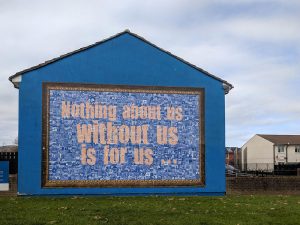Unlike our two other on-the-ground stories, this one exemplifies the “business” rationale for diversity—as a service provider in increasingly diverse Providence, the Planned Parenthood of Rhode Island experienced pressure from external systems to go against the grain of hiring and retaining mostly white people. That pressure along with other motivations resulted in the board’s decision to hire a CEO of color, and this made for a relatively smooth transition to a multicultural organization. We were particularly caught by the stories about how to build leadership of color and what you can accomplish when you’ve got it.
By the mid-90s, Planned Parenthood of Rhode Island was perceived as a social service organization that was culturally inaccessible to the changing demographic of potential customers and was relatively unapproachable by the other nonprofits in the community and by the neighborhood in which it was located. For many years the PPRI staff and board had, with few exceptions, remained overwhelmingly white and middle-class and almost exclusively English speaking.
It had a long and distinguished history of providing reproductive health care services for low-income women in Rhode Island, but it was growing increasingly isolated as that community changed.
Over a 10-year period (1990 to 2000) there was a 100 percent increase in the Hispanic1 population in Rhode Island. Today, 51 percent of Providence residents belong to one of several minority groups and include half of the entire state’s minority population. The Hispanic population is comprised primarily of people from the Dominican Republic as well as other Central and South American countries. There are also significant numbers of people from Liberia, Sierra Leone, Nigeria, Cape Verde, Portugal, Laos, Cambodia and a fairly significant Hmong community. Many of them are non-English speaking or have limited English language skills.
Staff of PPRI were not accustomed to serving people who didn’t speak English and whose cultural understanding of health care was very different from their own. Planned Parenthood provides reproductive health care services, which further complicates the picture, because providers must also be skilled in understanding cultural differences around sexuality, gender roles, family dynamics and general views about health care.
The board of PPRI knew that they needed to reach out to communities of color but had not had much success in making the necessary changes. To some extent, becoming more diverse is a question of extending one’s network, and they didn’t quite know how. When in 1995, the executive director of PPRI left for another position, the board began to search for a new CEO. The board made attending to diversity an underlying focus of the search process. They hired me, a black Cuban-American woman with a background in international family planning, program and community development. I had previously served as Director of Project Management for the international division of the Planned Parenthood Federation of America, where for 16 years I developed and evaluated family planning, education and income generation projects with local NGOs in Asia, Africa and Latin America.
The board’s decision to hire an executive committed to addressing issues of race and power was the catalyst for relatively fast-paced change. With the board’s support, I was able to launch a process of organizational transformation.
I began my approach by looking at the community that we serve. We provide medical and educational services to communities that are rapidly changing, speaking multiple languages; our customer base has changed. If we are to stay in business, we have to pay attention—and everyone understands that.
I gave people a chance to buy into the idea of change, to understand why it’s important. There are always people who like to do things the way they’ve always been done. A lot of what constitutes resistance is fear of the unknown or lack of information. I brought in an outside consultant to conduct diversity training for board and staff. As a result, people have a better understanding of the need to become a multicultural organization and what it takes. They see the benefits in more patients coming into the clinic and in our ability to serve them better. It was a slow but rewarding process.
I haven’t found this organization’s transformation that difficult—but, then again, I realize that being in the leadership role here makes a significant difference. Having the support and commitment of the board and key management staff has made the experience less painful than it might have been. My experience at PPRI exemplifies the importance of having more minority leadership in instituting change. (See Candidate Pipeline box for more on this.)
Being a black Cuban-American has also been helpful in terms of outreach. For example, it’s easier for me to go speak to the executive directors of the Hispanic and African American organizations to say that it’s very important to emphasize sexual health in “our community.” They know what I mean. There’s a good level of trust there. I can show them our teen pregnancy rates—Rhode Island has the highest teen pregnancy rate in New England, with a rate that is particularly high among Hispanic teens—and say, “This is not what we want for our children.” There is little chance that I will sound condescending or threatening when I say that they need to do more, and I offer our sexuality education services.
We also looked for multicultural and bilingual staff to accomplish our goals in reaching out to diverse communities and establishing collaborative relationships with social service organizations serving communities of color. Currently the director of the education department is a woman with extensive experience working with diverse populations. The two health educators are bilingual and bicultural professional women, one from Colombia and the other from Cape Verde. We have bilingual staff in our clinic. When our health educators go out to the community they speak the language that the community speaks, including the nuances of culture and tradition. As a result, we now have close working relationships with many more organizations serving the minority community.
Beyond the CEO, education and clinic departments, we have made every effort to increase the overall diversity of the board and staff. Over a six-year period the agency’s board and staff have begun to reflect more closely the racial diversity of the community. About one-third of the staff come from communities of color and are bilingual. The agency’s medical director is a Hispanic OB/GYN and community leader well respected in the state and nationwide reproductive health community.
The current board chair, an influential and respected retired educator, is the first African American woman to hold the position in the history of Planned Parenthood of Rhode Island. Increasing and maintaining diversity on the board and staff has become an institutionalized process, and there are currently systems in place as part of the board and staff recruitment process.
As an example, I’ve changed how I conduct recruitment. You often hear the excuse—“we didn’t find a qualified candidate.” To find nontraditional candidates, you have to look in nontraditional ways. Normally, we send descriptions of any positions that are open to a number of organizations—and receive very few responses from candidates of color. I started to send a personal letter—not just a form letter—from me to the heads of minority organizations, along with the announcement of the open position. As a result, we began to see more candidates of color. It didn’t require extra money—just letting people know that we are serious about this.
Sign up for our free newsletters
Subscribe to NPQ's newsletters to have our top stories delivered directly to your inbox.
By signing up, you agree to our privacy policy and terms of use, and to receive messages from NPQ and our partners.
That said, you bring together all these different kinds of people and find that there is a lot in common between us. What people want for themselves and their family is the same all over the world. People may do things in different ways, but that adds spice to the mix. For example, most people assume that among Hispanics discussions about sexuality and reproductive health are taboo subjects. But that’s not the case. Our Hispanic clients welcome the information we provide, and we have a number of Hispanic volunteers. We recently conducted a radio show for parents to teach their children about sexuality entirely in Spanish. It was well received, and we plan to do more. We can’t continue to just act based on assumptions.
Guiding changes in our programs is our five-year strategic plan, formulated in 2000. One key element of the planning was the inclusiveness of the process. It included focus groups with community organizations and a broad cross-section of board and staff members from every level of the organization. Everyone in the strategic planning committee, from clinic assistants to the board leadership, provided input into the plan’s goals and direction for the agency. A second key element is the general agreement that in order to expand our services and patient base, we needed to establish PPRI as a multicultural organization.
Although we don’t have the space to report all of the changes in our programs here, they are multiple and rich. We would like to mention one program that is illustrative of the far-reaching results one creative program can have.
We developed a Volunteer Interpreter for Choice program last year. The program provides reproductive health and interpretation training to bilingual volunteers who are on call to assist clinic patients during medical procedures. This assistance is particularly important to our abortion patients who find in these interpreters an understanding person who is with them through every step of the process. The program currently includes interpreters who speak Spanish, Portuguese, Vietnamese, Laotian and Creole. By “thinking outside of the box,” we’ve managed to address our clients’ needs without spending a ton of money. And one of the surprising results of including volunteer interpreters is that they have become committed to reproductive choice—we have now added “Advocacy 101” to their training, so that they are better able to become advocates for choice in their communities.
We have actively reached out to diverse communities through the organizations that represent them. We joined the Rhode Island Department of Health’s Minority Health Committee, a network designed to identify barriers to healthcare and develop programs that address disparities in health services. We also joined the neighborhood association of all the local businesses and invited them to hold meetings in the Planned Parenthood office. Once a year we hold a Male Responsibility Conference to address the issue of teen pregnancy with high school males. The last conference planning committee included approximately 30 people from community organizations throughout the state—a number that grows every year.
In addition to changes in staffing and programming, the agency also changed its look to better reflect the community it serves. The health center’s walls, from the reception area to exam rooms and boardrooms, are graced with multicultural art so that all who come to the center find a welcoming and friendly environment. The art was purchased through a board fundraiser for this specific purpose.
Making diversity part of the way we operate and manage our organization has also been fun. Our fundraiser this year was “Salsa at Sunset.” A week prior to the event we held a “Salsa Night” with board and staff participation. The bilingual educator and I gave dancing lessons to ensure full participation at the fundraiser!
At PPRI we’ve had commitment to creating a multicultural organization—not just a diversity program—from the agency leadership (the board and CEO). At the same time, we included all organizational levels in developing agency
goals. Our organization’s willingness to make a long-term commitment to institutionalizing diversity, as evidenced by the inclusion of a diversity goal (including a diverse board) in the agency’s five-year strategic plan, along with the commitment of our leadership, has led to our success at transforming the organization. Although the changes were precipitated by my arrival as CEO, ideally they will last long after my tenure here is over.
We want to establish PPRI as the model multicultural organization by creating diversity policies that affirm inclusion and respect and value differences at all levels of the organization. We are establishing guidelines to ensure accountability for increasing diversity and promoting cross-cultural understanding.
As part of our new commitment to diversity, we’ve demonstrated a willingness to reach out and form collaborative relationships with community organizations serving minority populations and join forces with them to address common goals. The idea is to get to the point where diversity is not a program that “we do,” but something we are!
1. Some people prefer the term “Latino” over the term “Hispanic.” As it is more common to use the term Hispanic in Rhode Island, for the purposes of this article we will use that term.
Planned Parenthood Federation of America (PPFA) recognizes the importance of increasing diversity at the top leadership level. Similar to many national organizations, the greatest degree of diversity is found among lower level positions. PPFA’s goal is to increase the diversity among the 127 Planned Parenthood Affiliates’ CEOs. A project is underway to examine structural solutions to increasing diversity, initiated by the CEO of the national organization, Gloria Feldt, with the support of the board (which for the first time is headed by a Latino man). One of their objectives is to fund and implement a CEO development program to build a pipeline of strong candidates of color for leadership roles. They plan to develop a pool of candidates, work with search committees of boards, help boards diversify themselves, and improve recruitment and retention programs to increase the diversity of volunteers throughout the Federation.
The program is currently in the research and planning phase to determine the methods that have led to diverse pools of candidates and subsequent hiring of people of color as senior managers and CEOs. Additionally, they will explore and eliminate barriers that exist. “We want to make it easy for boards of directors to hire a person of color,” said Linda Gonzalez, vice president for diversity of Planned Parenthood. “So, we’re pursuing multiple strategies—developing an internal pool of candidates who are ready to step into open positions, promoting various recruitment methods, building a resume bank, locating search firms that specialize in developing diverse candidate pools, and encouraging current CEOs to think about succession planning.”
One subtle barrier to hiring from communities of color is that in such communities multiple issues are important. Thus, when someone comes in for an interview, reproductive health and rights may be at the top of their agenda along with immigrant rights and environmental justice. “Not everyone views the ability to advocate for multiple issues simultaneously as a strength,” said Gonzalez. “But I do—I recognize that it’s not a lack of commitment to any one issue. Assumptions about people’s priorities can get in the way.”
Miriam Inocencio has been the president and CEO of Planned Parenthood of Rhode Island since 1995. Claire Gravon is the senior associate director of the Affiliate Resources and Consulting Group of the Planned Parenthood Federation of America.









